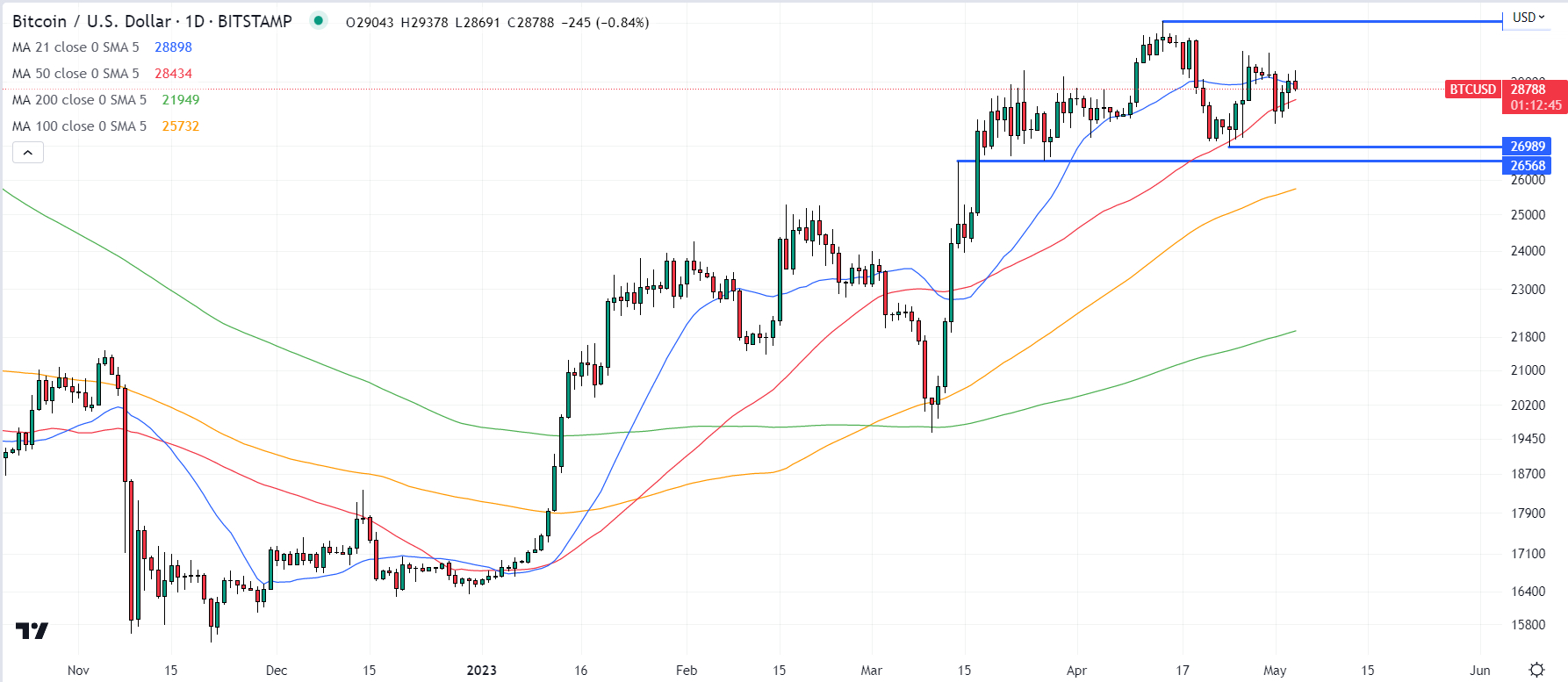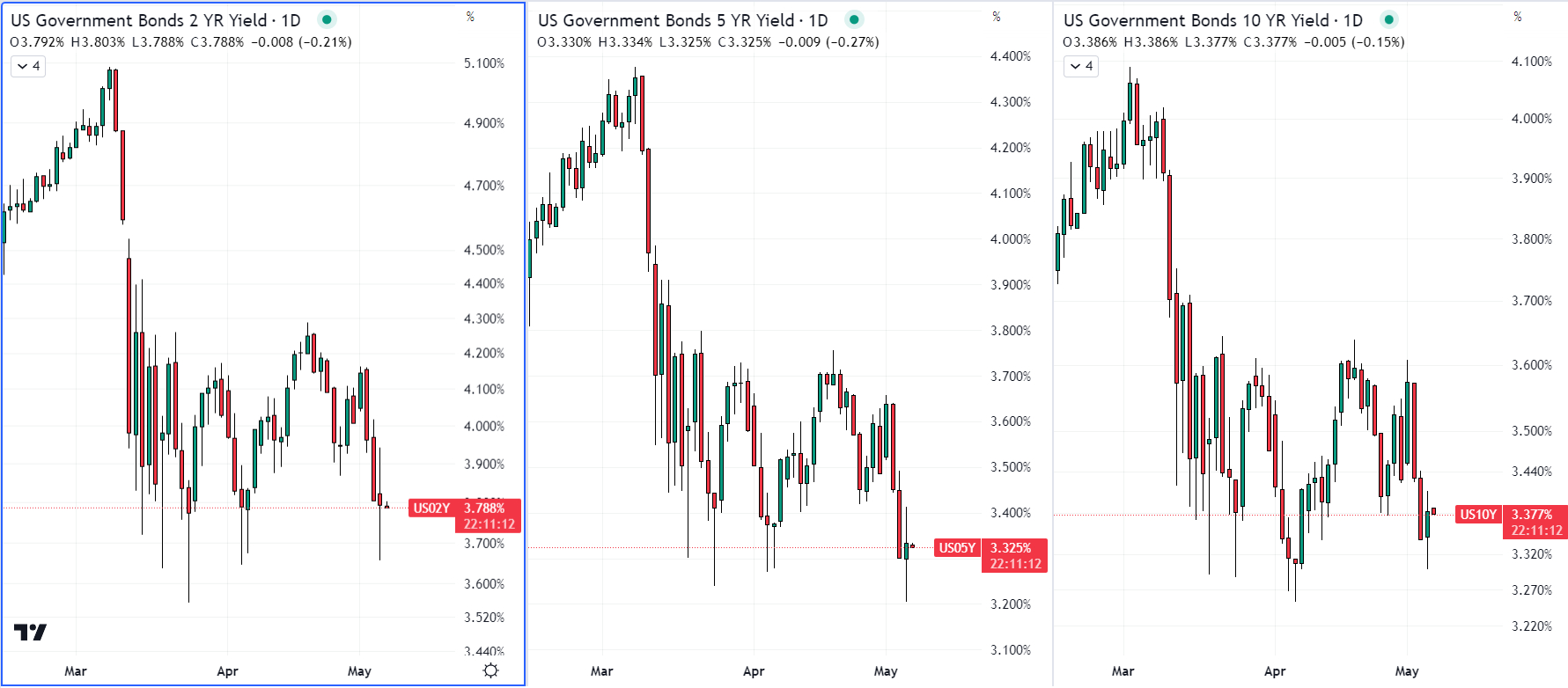Bitcoin (BTC) continues to consolidate within familiar ranges close to $29,000 ahead of the release of key US jobs data on Friday.
The data, which is expected to show that the pace of hiring and wage growth in the US remains robust, and that the unemployment rate remains close to historic lows, come on the heels of a 25 bps rate hike from the US Federal Reserve earlier this week.
The US central bank lifted its Federal Funds target range to 5.0-5.25% as broadly expected by market participants, marking 500 bps worth of tightening in its last 10 meetings.
The Fed has spent the last year tightening financial conditions in order to get a surge in US inflationary pressures that began in 2021 under control.
Bitcoin didn’t see much volatility in wake of the meeting and remains well within the $27,000-$31,000ish range that has been in play since March.

Recent Bitcoin price action suggests the market is in a state of indecision as to where Bitcoin is headed next.
Is a break back above $30,000 on the cards, or a drop back to support in the $25,000 area?
Well, one of the world’s most important asset classes might be giving traders a clue – that is, the US Treasury market.
With Yields About to Break Lower, Could This Signal an Incoming Bitcoin (BTC) Price Pump?
While upcoming US jobs data is likely to show that the US labor market remained in good health in March, cracks are already appearing.
The latest US JOLTs survey released earlier this week showed job openings in the US falling to fresh two-year lows, with weaker labor demand a lead indicator of eventual job losses.
And expectations for a weaker US labor market later this year add to the reasons why this week’s hike from the Fed was likely the last of this tightening cycle.
Other sectors of the US economy (like the manufacturing sector, which ISM PMI survey data suggests is in contraction) are also weakening as the headwind of one year’s worth of aggressive monetary tightening from the Fed starts to bite.
Perhaps more importantly, a significant new headwind to the US economy has arrived in the form of a worsening bank crisis.
After First Republic became the fourth major US bank to fail in under two months, dozens of other regional banks are teetering, and this has been dragging bank sector stocks lower.
Bank sector troubles are expected to result in a significant contraction in lending, a key driver of growth, raising recession risks substantially.
All of this means that, more likely than not, the Fed will have to start cutting interest rates later this year to support growth.
As economic risks and the likelihood of a near-term Fed interest rate cutting cycle rise, US treasury markets have been taking notice.
The 2-year yield hit fresh one-month lows under 3.7% on Thursday, the 5-year hit its lowest levels since last September close to 3.2% and the 10-year yield is threatening a break below key support around 3.3%.

If yields continue to head lower, which seems likely in the medium-term given the worsening bank crisis (and even if Friday’s US jobs data exceeds expectations), represents (and also itself creates) a more favorable macro backdrop for cryptocurrencies like Bitcoin.
In recent history, Bitcoin has performed well during times of easing financial conditions (i.e. falling yields).
It can also count on a new medium-term tailwind in the form of safe-haven demand as investors look for “hard-money” alternatives to fiat currencies – like gold and Bitcoin – as financial stability concerns rise.
Assuming the downtrend in US yields continues amid bank crisis/rising recession risk woes, and assuming that this also hits the value of the US dollar (which is also negatively correlated to Bitcoin), risks are tilted more towards a possible near-term Bitcoin price pump as opposed to a new bear market.
Bitcoin (BTC) continues to consolidate within familiar ranges close to $29,000 ahead of the release of key US jobs data on Friday.
The data, which is expected to show that the pace of hiring and wage growth in the US remains robust, and that the unemployment rate remains close to historic lows, come on the heels of a 25 bps rate hike from the US Federal Reserve earlier this week.
The US central bank lifted its Federal Funds target range to 5.0-5.25% as broadly expected by market participants, marking 500 bps worth of tightening in its last 10 meetings.
The Fed has spent the last year tightening financial conditions in order to get a surge in US inflationary pressures that began in 2021 under control.
Bitcoin didn’t see much volatility in wake of the meeting and remains well within the $27,000-$31,000ish range that has been in play since March.

Recent Bitcoin price action suggests the market is in a state of indecision as to where Bitcoin is headed next.
Is a break back above $30,000 on the cards, or a drop back to support in the $25,000 area?
Well, one of the world’s most important asset classes might be giving traders a clue – that is, the US Treasury market.
With Yields About to Break Lower, Could This Signal an Incoming Bitcoin (BTC) Price Pump?
While upcoming US jobs data is likely to show that the US labor market remained in good health in March, cracks are already appearing.
The latest US JOLTs survey released earlier this week showed job openings in the US falling to fresh two-year lows, with weaker labor demand a lead indicator of eventual job losses.
And expectations for a weaker US labor market later this year add to the reasons why this week’s hike from the Fed was likely the last of this tightening cycle.
Other sectors of the US economy (like the manufacturing sector, which ISM PMI survey data suggests is in contraction) are also weakening as the headwind of one year’s worth of aggressive monetary tightening from the Fed starts to bite.
Perhaps more importantly, a significant new headwind to the US economy has arrived in the form of a worsening bank crisis.
After First Republic became the fourth major US bank to fail in under two months, dozens of other regional banks are teetering, and this has been dragging bank sector stocks lower.
Bank sector troubles are expected to result in a significant contraction in lending, a key driver of growth, raising recession risks substantially.
All of this means that, more likely than not, the Fed will have to start cutting interest rates later this year to support growth.
As economic risks and the likelihood of a near-term Fed interest rate cutting cycle rise, US treasury markets have been taking notice.
The 2-year yield hit fresh one-month lows under 3.7% on Thursday, the 5-year hit its lowest levels since last September close to 3.2% and the 10-year yield is threatening a break below key support around 3.3%.

If yields continue to head lower, which seems likely in the medium-term given the worsening bank crisis (and even if Friday’s US jobs data exceeds expectations), represents (and also itself creates) a more favorable macro backdrop for cryptocurrencies like Bitcoin.
In recent history, Bitcoin has performed well during times of easing financial conditions (i.e. falling yields).
It can also count on a new medium-term tailwind in the form of safe-haven demand as investors look for “hard-money” alternatives to fiat currencies – like gold and Bitcoin – as financial stability concerns rise.
Assuming the downtrend in US yields continues amid bank crisis/rising recession risk woes, and assuming that this also hits the value of the US dollar (which is also negatively correlated to Bitcoin), risks are tilted more towards a possible near-term Bitcoin price pump as opposed to a new bear market.
